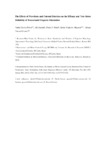Mostrar o rexistro simple do ítem
The effects of waveform and current direction on the efficacy and test–retest reliability of transcranial magnetic stimulation
| dc.contributor.author | Davila-Pérez, Paula | |
| dc.contributor.author | Jannati, Ali | |
| dc.contributor.author | Fried, Peter J. | |
| dc.contributor.author | Cudeiro, Javier | |
| dc.contributor.author | Pascual-Leone, Alvaro | |
| dc.date.accessioned | 2022-05-11T08:41:16Z | |
| dc.date.available | 2022-05-11T08:41:16Z | |
| dc.date.issued | 2018-10-06 | |
| dc.identifier.citation | Davila-Pérez P, Jannati A, Fried PJ, Cudeiro J, Pascual-Leone A. The effects of waveform and current direction on the efficacy and test–retest reliability of transcranial magnetic stimulation. Neurosci. 2018;393:97-109 | es_ES |
| dc.identifier.issn | 0306-4522 | |
| dc.identifier.uri | http://hdl.handle.net/2183/30639 | |
| dc.description.abstract | [Abstract] The pulse waveform and current direction of transcranial magnetic stimulation (TMS) influence its interactions with the neural substrate; however, their role in the efficacy and reliability of single- and paired-pulse TMS measures is not fully understood. We investigated how pulse waveform and current direction affect the efficacy and test–retest reliability of navigated, single- and paired-pulse TMS measures. 23 healthy adults (aged 18–35 years) completed two identical TMS sessions, assessing resting motor threshold (RMT), motor-evoked potentials (MEPs), cortical silent period (cSP), short- and long-interval intra-cortical inhibition (SICI and LICI), and intracortical facilitation (ICF) using either monophasic posterior–anterior (monoPA; n = 9), monophasic anterior–posterior (monoAP; n = 7), or biphasic (biAP-PA; n = 7) pulses. Averages of each TMS measure were compared across the three groups and intraclass correlation coefficients were calculated to assess test–retest reliability. RMT was the lowest and cSP was the longest with biAP-PA pulses, whereas MEP latency was the shortest with monoPA pulses. SICI and LICI had the largest effect with monoPA pulses, whereas only monoAP and biAP-PA pulses resulted in significant ICF. MEP amplitude was more reliable with either monoPA or monoAP than with biAP-PA pulses. LICI was the most reliable with monoAP pulses, whereas ICF was the most reliable with biAP-PA pulses. Waveform/current direction influenced RMT, MEP latency, cSP, SICI, LICI, and ICF, as well as the reliability of MEP amplitude, LICI, and ICF. These results show the importance of considering TMS pulse parameters for optimizing the efficacy and reliability of TMS neurophysiologic measures. | es_ES |
| dc.description.sponsorship | A.J. was supported by postdoctoral fellowships from the Natural Sciences and Engineering Research Council of Canada (NSERC PDF 454617) and the Canadian Institutes of Health Research (CIHR 41791). P.J.F. was supported in part by the National Institutes of Health (R21 NS082970R21 AG051846). J.C.M. was supported in part by a Salvador de Madariaga Fellowship for visiting scientists (Ministry of Education, Culture and Sport, Spain). A.P.-L. was supported in part by the Sidney R. Baer Jr. Foundation, the National Institutes of Health (NIH R01 MH100186, R01 NS073601, R01 HD069776, R21 MH099196, R21 NS082870; R21 NS085491, R21 HD07616), the Football Players Health Study at Harvard University, and Harvard Catalyst | The Harvard Clinical and Translational Science Center (NCRR and the NCATS NIH, UL1 RR025758). | |
| dc.description.sponsorship | Natural Sciences and Engineering Research Council of Canada; NSERC PDF 454617 | |
| dc.description.sponsorship | Canadian Institutes of Health Research; CIHR 41791 | |
| dc.description.sponsorship | United States. National Institutes of Health; R21 NS082970R21 AG051846 | |
| dc.description.sponsorship | United States. National Institutes of Health; R01 MH100186 | |
| dc.description.sponsorship | United States. National Institutes of Health; R01 NS073601 | |
| dc.description.sponsorship | United States. National Institutes of Health; R01 HD069776 | |
| dc.description.sponsorship | United States. National Institutes of Health; R21 MH099196 | |
| dc.description.sponsorship | United States. National Institutes of Health; R21 NS082870 | |
| dc.description.sponsorship | United States. National Institutes of Health; R21 NS085491 | |
| dc.description.sponsorship | United States. National Institutes of Health; R21 HD07616 | |
| dc.language.iso | eng | es_ES |
| dc.publisher | Elsevier | es_ES |
| dc.relation.uri | https://doi-org.accedys.udc.es/10.1016/j.neuroscience.2018.09.044 | es_ES |
| dc.rights | Creative Commons Attribution-NonCommercial-NoDerivs 4.0 International License (CC-BY -NC-ND 4.0) | es_ES |
| dc.rights.uri | http://creativecommons.org/licenses/by-nc-nd/4.0/ | * |
| dc.subject | Transcranial magnetic stimulation | es_ES |
| dc.subject | Current direction | es_ES |
| dc.subject | Monophasic waveform | es_ES |
| dc.subject | Biphasic waveform | es_ES |
| dc.subject | Paired-pulse | es_ES |
| dc.subject | Reliability | es_ES |
| dc.title | The effects of waveform and current direction on the efficacy and test–retest reliability of transcranial magnetic stimulation | es_ES |
| dc.type | info:eu-repo/semantics/article | es_ES |
| dc.rights.access | info:eu-repo/semantics/openAccess | es_ES |
| UDC.journalTitle | Neuroscience | es_ES |
| UDC.volume | 393 | es_ES |
| UDC.startPage | 97 | es_ES |
| UDC.endPage | 109 | es_ES |






